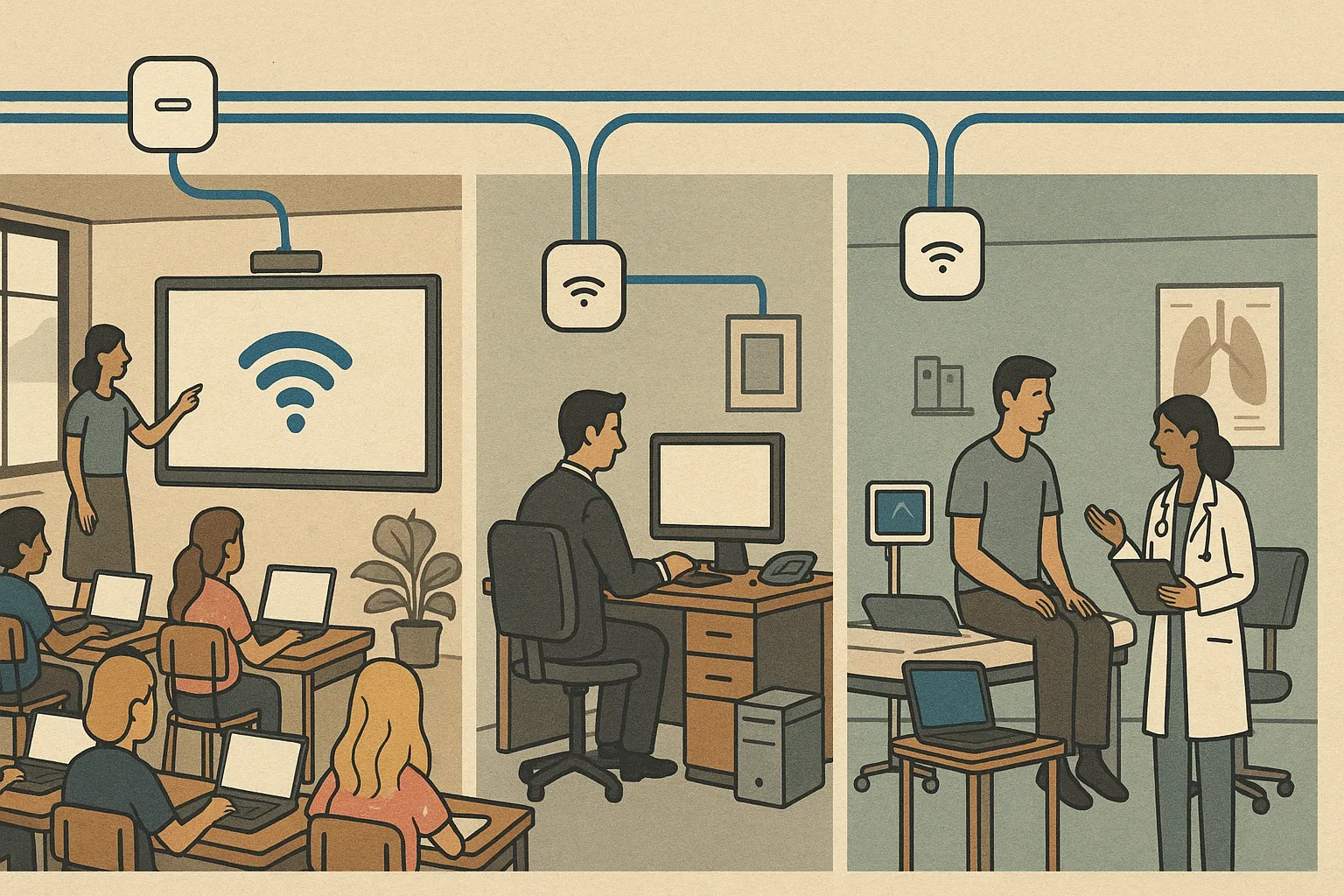Introduction
Picture this: It’s Monday morning in your Chillicothe office and everyone is ready to work, but the network is crawling. A tangle of unlabelled wires in the closet has struck again, knocking out a critical connection. Frustrating, right? In today’s workplaces – whether a small business in Brookfield, a school in Moberly, or a clinic in Trenton – reliable connectivity is as essential as electricity. This is where structured cabling comes in. While it might not be flashy, structured cabling serves as the nervous system of your IT environment, keeping data flowing smoothly so you can focus on operations. In fact, as of 2024 roughly 80% of enterprises are shifting to cloud-based systems, making a robust cabling infrastructure crucial for seamless connectivity. Let’s explore what structured cabling is and how it can transform your office or campus for the better.

What is Structured Cabling?
Structured cabling is an industry-standard approach to designing and organizing an organization’s overall cabling infrastructure. Think of it as the physical backbone of your network that ties together all computers, phones, and other devices. Instead of a jumble of patch cords running every which way, structured cabling uses a planned, standardized layout of high-quality cables, patch panels, and jacks to keep your connections neat and efficient. The structured approach means all your data, voice, and video signals have clear, reliable pathways throughout the building. In plain English, structured cabling is organized wiring that ensures all your tech – from PCs to VoIP phones – can communicate without a hitch.
A proper structured cabling system adheres to TIA/EIA standards and typically encompasses several subsystems (like vertical cabling between floors and horizontal cabling to workstations). You don’t need to know the technical specs, though. What matters is that this structured setup replaces ad-hoc “spaghetti” wiring with a cohesive, labeled system. The result? Easier management, fewer errors, and a network that’s built to support your needs now and in the future. As one tech expert put it, structured cabling isn’t just about cables – it’s about creating a foundation for all your current and future technology needs.

Fast, Reliable Connectivity Every Day
One of the biggest immediate impacts of structured cabling is a faster, more reliable network. Modern high-grade cables (like Cat6 or fiber optics) can carry data at blazing speeds with minimal interference. If your office relies on large file transfers, HD video meetings, or cloud applications, structured cabling ensures you have the bandwidth to keep up. Upgrading from old, thin wiring to newer cabling can boost network speeds and reduce latency, meaning snappier access to cloud apps and less lag during video calls. In short, everything feels “quicker” when your cabling isn’t a bottleneck.
Just as important is network reliability. An unorganized tangle of cords is prone to loose connections and signal interference. (Have you ever lost half a day chasing a bad cable? It’s not fun.) Structured cabling uses better materials and shields that cut down on electrical noise and signal loss. This translates to a more stable connection and fewer outages. In fact, older cabling setups often suffer from interference and wear that lead to frequent downtime, whereas structured cabling’s robust design prevents many of those issues. For your office, that means uninterrupted operations – no more random network drops in the middle of a workday. Reliable connectivity isn’t just an IT perk; it directly prevents costly lost productivity due to network downtime.
Consider a local example: a school district office in Moberly implemented structured cabling and saw their internet outages drop dramatically. Where staff once held their breath during online testing or live stream events, they now have confidence in a stable connection. The same goes for businesses – a reliable network keeps POS systems running in a retail store and ensures doctors can pull up patient records quickly in a healthcare clinic. It’s all powered by the behind-the-scenes wiring. Structured cabling provides that rock-solid foundation so day-to-day work goes on without a hitch.

Simplified Maintenance and Room to Grow
Another major benefit of structured cabling is how much easier it makes managing and scaling your network. With a neatly organized system, gone are the days of tracing a mystery cord through a rat’s nest for hours. Every cable in a structured system is terminated cleanly and often labeled, so identifying where a connection leads is straightforward. This simplifies troubleshooting dramatically – when there’s an issue, IT staff (or your managed service provider) can quickly pinpoint and fix it. That means less time fighting wiring issues and more time being productive. Because problems are easier to locate and resolve, structured cabling naturally leads to reduced downtime for your organization. No one likes telling their team to stop work because “the network is down.” An organized cabling layout helps make those dreaded announcements a rarity.
Structured cabling also gives you flexibility to expand without chaos. Need to add five new workstations in an office or set up a new computer lab at a school? With structured cabling, accommodating new devices or reconfiguring spaces is relatively plug-and-play. The system is designed to be modular and scalable. You can add, move, or change connections without messing up the entire network. One source notes that with high-bandwidth structured systems, you can introduce new applications (like video conferencing or smart boards) without interrupting your current setup. In practice, that means your cabling won’t become obsolete every time technology advances.
Key advantages of this flexibility include:
- Easy Troubleshooting: Cables are organized and labeled, so technicians can isolate and fix issues quickly (no more hunting for a needle in a haystack of wires).
- Quick Moves/Adds/Changes: Whether you’re rearranging the office in Cameron or adding IP security cameras at a Chillicothe municipal building, structured cabling makes the process efficient and minimizes disruption.
- Scalability: As your business or institution grows, a structured network has the capacity (and available ports) to scale up. High-quality cabling supports more devices and higher data loads as you expand, without a drop in performance.
- Consistent Performance: Even as new connections are added, the standardized design means each gets the same reliable, fast service – there’s no tangle to degrade signals or cause random errors.
Structured cabling treats your network like a well-organized highway system instead of a jumble of backroads. Everything is mapped out, so adding one more “car” (device) won’t cause a traffic jam. This is especially important for places like growing businesses or schools that anticipate more users and tech needs in the coming years. With structured cabling, you won’t need a costly rewire every time you expand – your infrastructure is already primed to handle it.

Future-Proof Infrastructure
Technology evolves quickly – think about how office networks from 10 years ago struggled with today’s cloud apps and streaming video. One of the smartest reasons to invest in structured cabling is to future-proof your organization’s infrastructure. Future-proofing means preparing your network to support emerging technologies and higher demands so you’re not constantly playing catch-up. A well-designed cabling system has high bandwidth capacity and can integrate new hardware with minimal fuss. As one industry report highlights, businesses are upgrading their cabling to support 10 Gigabit speeds and beyond, since about 85% of enterprises now rely on cloud computing and can’t afford network bottlenecks. With structured cabling, you’re building a network that’s ready for the next generation of applications.
How does this look in real life? Imagine your health clinic in Trenton wants to add telemedicine stations or your city hall in Chillicothe is installing smart IoT sensors for building security. Structured cabling can handle these new tech rollouts without needing a complete overhaul. It’s designed to accommodate advancements – higher wireless access point densities, Power over Ethernet (PoE) devices like security cameras or VoIP phones, and even all-fiber connections for ultra-high speeds. In fact, structured systems are often built with plenty of headroom, meaning they won’t max out when you introduce something new. One cabling specialist notes that structured cabling has a longer lifespan than ad-hoc wiring, serving as a long-term “investment” that pays off for years, possibly decades.
Crucially, structured cabling also contributes to network security and reliability in the future. Its organized nature allows for easier implementation of network segmentation – a practice where you isolate portions of your network for security (important for things like guest Wi-Fi or sensitive data zones). And with quality cabling, you reduce the risk of crosstalk and interference that could expose data or cause errors. For industries like healthcare and finance, having secure, low-error data channels is non-negotiable. Structured cabling provides the stable groundwork to meet those compliance and security needs as they evolve.
Lastly, let’s talk cost savings. Yes, structured cabling requires an upfront investment – quality cables and professional installation aren’t the cheapest line items. But over time, it saves money. How? By dramatically reducing maintenance and downtime costs. A well-organized network experiences fewer failures and less frequent repairs, which keeps your IT budget in check. And when upgrades are needed, you can often reuse the existing cabling backbone instead of rewiring everything, saving on future installation expenses. Businesses that implement structured cabling often find that while they paid more on day one, they avoided many hidden costs that come with a messy network (like emergency outages, inefficient troubleshooting, or even higher cooling/electricity usage from tangled cables). Over the long run, an investment in structured cabling equates to investing in reliability – and reliability pays off.

Real-World Impact for Businesses, Schools, and Clinics
Structured cabling might sound like an IT concern, but its impact is very real for people working in all kinds of environments. Here are a few examples of how a solid cabling infrastructure makes a difference in various local settings:
- Small & Mid-Sized Businesses: For a growing business in Brookfield or Cameron, structured cabling ensures that your computers, printers, phones, and cloud apps all stay connected without hiccups. Fewer network problems mean your team can collaborate and serve customers without delay. Plus, adding new employees or moving offices is simpler when your network is plug-and-play ready.
- Schools & Educational Campuses: Digital learning is only as good as the network that supports it. In schools (from Chillicothe High to regional colleges), structured cabling provides high-speed, dependable internet access in every classroom. Students can take online exams or stream video lessons without the network choking. And it’s not just about internet – everything from interactive smart boards to security cameras runs on that cabling. A structured network keeps it all humming reliably and is easy to expand as technology in education evolves.
- Municipal & Government Offices: Local governments rely on stable networks for public safety communications, utility management systems, and day-to-day admin work. A city office in Trenton or Chillicothe benefits from structured cabling by having a secure, stable backbone for services like 911 dispatch, building security systems, and internal databases. When networks are organized and robust, city employees can better serve the community without IT downtime getting in the way.
- Healthcare Practices & Clinics: In healthcare, seconds matter. A clinic or independent practice needs instant access to electronic health records, reliable email and phone systems, and sometimes remote consultation tools. Structured cabling offers the speed and reliability for critical data – no dropped connections during a telehealth session, and quick retrieval of patient charts even during peak hours. It also supports secure channels for sensitive information, helping protect patient confidentiality by keeping the network controlled and less prone to breaches. Simply put, an organized network can literally help healthcare providers save lives through better communication.
Across all these examples, a common theme emerges: structured cabling turns your network into a strong, silent partner in your operations. When done right, it’s practically invisible – you forget it’s even there (because nothing’s breaking!). But you’ll certainly feel the difference in productivity, safety, and peace of mind. Even in a region like north-central Missouri, far from the big-city tech hubs, organizations large and small are leveraging structured cabling to run modern, efficient operations.
Bottom line: if consistent connectivity and room to grow are important to you, structured cabling is worth the effort. It’s the kind of upgrade that supports everything else you do.

The Bottom Line: Invest in Your Foundation
The network demands on businesses and institutions will only increase in the coming years. By adopting structured cabling now, you equip your office with a future-ready foundation that can adapt to new challenges and technologies with ease. No more worrying that a new software system or additional users will crash your setup – a structured network is built to handle it. Additionally, you’ll enjoy immediate perks like faster data speeds, easier maintenance, and less surprise downtime.
Ready to strengthen your organization’s backbone? Investing in structured cabling is investing in peace of mind. If you’re located in Chillicothe or the surrounding Missouri region, consider reaching out to a local IT partner like Pinpoint Tech for guidance. Our team has helped businesses and schools from Cameron to Brookfield to Kansas City design cabling solutions that fit their needs and budget. We’d be happy to do the same for you. Contact us today to learn how structured cabling can support your operations – and let’s build a network that keeps you running at full speed.

FAQs: Structured Cabling & Office Networks
What is structured cabling, in simple terms?
Structured cabling is a standardized approach to organizing all the network wiring in your building. Instead of random cables running point-to-point, it uses an organized system of high-quality cables, patch panels, and jacks to create a neat, reliable network infrastructure. In plain terms, it’s the backbone that connects all your phones, computers, and other devices so they can communicate efficiently.
How does structured cabling improve network reliability?
Is structured cabling only for big companies, or can small offices benefit too?
Structured cabling is beneficial for organizations of all sizes. Small and mid-sized businesses actually stand to gain a lot – it makes it easy to add new equipment as you grow and prevents small IT issues from snowballing into big outages. Even in a 5-person office, having a tidy, robust network setup can save time and headaches. Plus, the investment scales with your size; you can implement a structured solution that fits a small office budget and expand it over time.
Will structured cabling support future technologies we might use?
Absolutely. A core advantage of structured cabling is its high bandwidth and scalability. It’s designed to handle emerging tech like higher-speed Wi-Fi access points, advanced VoIP phone systems, or more cloud computing usage without needing a major rework. For example, if you upgrade to new servers or roll out IoT devices, a structured network can accommodate those additions. This future-proofing means your cabling infrastructure won’t become obsolete quickly.
Do we still need structured cabling if most of our devices use Wi-Fi?
In almost all cases, yes – you still need a solid wired backbone. Think of Wi-Fi access points, servers, and switches: they all connect via cables behind the scenes. Structured cabling provides the wired infrastructure that powers robust wireless coverage. It ensures your wired connections (for stationary devices like desktops, printers, and critical systems) are fast and reliable, which in turn supports better Wi-Fi performance. In short, Wi-Fi and structured cabling work hand-in-hand; a great wireless experience is only possible if the wired network behind it is strong.
Is structured cabling expensive, and what’s the return on investment?
The upfront cost is higher than patchwork wiring, but the return on investment can be significant. With structured cabling, you’ll have far fewer network issues, less downtime, and lower maintenance costs over time. It also saves money when expanding or reconfiguring your office, since you won’t need to rip out and redo cabling each time. Many organizations find that avoiding just one major network outage or eliminating a few service calls pays back the cost. Plus, the improved performance and productivity gains for your staff are a huge bonus – it’s hard to put a price on everyone being able to work smoothly without tech frustrations.
Sources
- Porter Technology, “Top Benefits of Upgrading Your Office Network Cabling,” Porter Low Voltage, May 17, 2024.
https://porterlowvoltage.com/top-benefits-of-upgrading-your-office-network-cabling/ - BCS Consultants, “5 Benefits of Structured Cabling Systems in Your Business,” Sep. 21, 2023.
https://www.bcsconsultants.com/blog/5-benefits-of-structured-cabling-systems-in-your-business/ - ReLite, “Building a Connected Campus: Structured Cabling in Education,” Oct. 26, 2024.
https://relite.io/blogs/news/building-a-connected-campus-structured-cabling-in-education - Ask Technolink, “Why Your Business Should Utilize Structured Cabling,” Nov. 16, 2023.
https://www.asktechnolink.com/blog?p=why-your-business-should-utilize-structured-cabling-231116 - AccuTech Communications, “IT Structured Cabling: Top 6 Essential Benefits 2024,” 2024.
https://accutechcom.com/it-structured-cabling/ - Global Growth Insights, “Structured Cabling Market Trends & Forecast 2025–2033,” Apr. 28, 2025.
https://www.globalgrowthinsights.com/market-reports/structured-cabling-market-106439 - ReLite, “Long-Term Cost Savings with Structured Cabling,” 2025.
https://relite.io/blogs/news/building-a-connected-campus-structured-cabling-in-education
